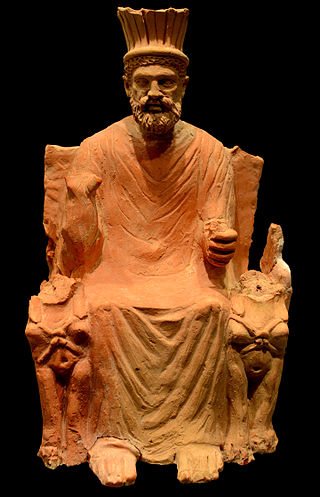The Phoenician alphabet is an abjad used across the Mediterranean civilization of Phoenicia for most of the 1st millennium BC. It was one of the first alphabets, and attested in Canaanite and Aramaic inscriptions found across the Mediterranean region. In the history of writing systems, the Phoenician script also marked the first to have a fixed writing direction—while previous systems were multi-directional, Phoenician was written horizontally, from right to left. It developed directly from the Proto-Sinaitic script used during the Late Bronze Age, which was derived in turn from Egyptian hieroglyphs.
Phoenician is an extinct Canaanite Semitic language originally spoken in the region surrounding the cities of Tyre and Sidon. Extensive Tyro-Sidonian trade and commercial dominance led to Phoenician becoming a lingua franca of the maritime Mediterranean during the Iron Age. The Phoenician alphabet spread to Greece during this period, where it became the source of all modern European scripts.

The Punic language, also called Phoenicio-Punic or Carthaginian, is an extinct variety of the Phoenician language, a Canaanite language of the Northwest Semitic branch of the Semitic languages. An offshoot of the Phoenician language of coastal West Asia, it was principally spoken on the Mediterranean coast of Northwest Africa, the Iberian Peninsula and several Mediterranean islands, such as Malta, Sicily, and Sardinia by the Punic people, or western Phoenicians, throughout classical antiquity, from the 8th century BC to the 6th century AD.

Astarte is the Hellenized form of the Ancient Near Eastern goddess ʿAṯtart. ʿAṯtart was the Northwest Semitic equivalent of the East Semitic goddess Ishtar.

Baal Hammon, properly Baʿal Ḥamon, meaning "Lord Hammon", was the chief god of ancient Carthage. He was a weather god considered responsible for the fertility of vegetation and esteemed as king of the gods. He was depicted as a bearded older man with curling ram's horns. Baʿal Ḥammon's female cult partner was Tanit.

Canaanite religion was a group of ancient Semitic religions practiced by the Canaanites living in the ancient Levant from at least the early Bronze Age to the first centuries CE. Canaanite religion was polytheistic and in some cases monolatristic. It was influenced by neighboring cultures, particularly ancient Egyptian and Mesopotamian religious practices. The pantheon was headed by the god El and his consort Asherah, with other significant deities including Baal, Anat, Astarte, and Mot.

The Byblos script, also known as the Byblos syllabary, Pseudo-hieroglyphic script, Proto-Byblian, Proto-Byblic, or Byblic, is an undeciphered writing system, known from ten inscriptions found in Byblos, a coastal city in Lebanon. The inscriptions are engraved on bronze plates and spatulas, and carved in stone. They were excavated by Maurice Dunand, from 1928 to 1932, and published in 1945 in his monograph Byblia Grammata. The inscriptions are conventionally dated to the second millennium BC, probably between the 18th and 15th centuries BC.

The Ahiram sarcophagus was the sarcophagus of a Phoenician King of Byblos, discovered in 1923 by the French excavator Pierre Montet in tomb V of the royal necropolis of Byblos.

The Byblian royal inscriptions are five inscriptions from Byblos written in an early type of Phoenician script, in the order of some of the kings of Byblos, all of which were discovered in the early 20th century.

The Osorkon Bust, also known as the Eliba'l Inscription is a bust of Egyptian pharaoh Osorkon I, discovered in Byblos in the 19th century. Like the Tabnit sarcophagus from Sidon, it is decorated with two separate and unrelated inscriptions – one in Egyptian hieroglyphics and one in Phoenician script. It was created in the early 10th century BC, and was unearthed c. 1881, very likely in the Temple of Baalat Gebal.

The Mdina steles are two Phoenician language inscriptions found near the city of Mdina, Malta, in 1816. The findspot is disputed; the oldest known description places it near the Tal-Virtù Church. The surviving stele is currently in the National Museum of Archaeology, Malta; the other stele has been considered lost for more than a century.

The Honeyman inscription, also known as the Archaic Cyprus inscription, is a seven-line Phoenician gravestone inscription found in Cyprus and first published in 1939. It is the oldest detailed Phoenician inscription found in Cyprus.

The Byblos marble inscription is a Phoenician inscription on a white marble fragment of a sarcophagus discovered around 1957 in the courtyard of Byblos Castle in the area where the east wall of the tower was located. It has been dated to 550-450 BCE, the period of the Achaemenid Empire; line 3 of the inscription is thought to refer to a Persian king. The inscription also refers to myrrh.

The Safatba'al inscription or the Shipitbaal inscription is a Phoenician inscription found in Byblos in 1936, published in 1945.

The Yehimilk inscription is a Phoenician inscription published in 1930, currently in the museum of Byblos Castle.

The Abda sherd graffito is a Phoenician inscription on a two small connecting fragment of a large vase, dating to c. 900 BC.

The Son of Safatba'al inscription is a Phoenician inscription dated to c. 500-475 BCE.

The Batnoam inscription is a Phoenician inscription on a sarcophagus. It is dated to c. 450-425 BCE.

The Byblos bronze spatulas are a number bronze spatulas found in Byblos, two of which were inscribed. One contains a Phoenician inscription and one contains an inscription in the Byblos syllabary.

Phoenician votive inscriptions or Punic votive inscriptions are votive inscriptions in the Phoenician and Punic religion, dedicated to a certain god or gods, mostly on stelae. The inscriptions have a standard formula, including the name of the god, the statement of the vow, the name of the vower and a closing statement. Most of the inscriptions were found in Carthage, and dedicated to Tinnit, Baʿal Ḥammon or both.

















